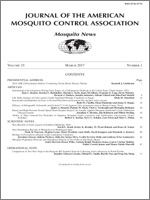James A. Dennett, Pamela M. Stark, Chris L. Fredregill, Mustapha Debboun
Journal of the American Mosquito Control Association 33 (1), 36-42, (1 March 2017) https://doi.org/10.2987/16-6617.1
KEYWORDS: adulticide, Culex quinquefasciatus, deltamethrin, insecticide resistance, malathion, permethrin, ultra-low volume
The comparative efficacy of ultra-low volume applications of deltamethrin, permethrin, and malathion against specific adult populations of Culex quinquefasciatus, a primary regional vector of Saint Louis encephalitis and West Nile virus, using field cage tests is described. At labeled application rates, the estimated mass median diameters for Fyfanon®, Evoluer™, and DeltaGard® were 18.32, 19.24, and 17.44 μm, respectively. No significant differences (P ≥ 0.01) in mean percent control were observed across all 3 wild populations and a susceptible Sebring strain tested with Fyfanon, DeltaGard, and Evoluer, providing 98.25%, 98.20%, and 97.24% mean percent control. Mean percent control for Sebring and 3 wild populations was 99.38%, 97.79%, 97.26%, and 97.15%, respectively, which were not significantly different from one another (P ≥ 0.01). Across all tests, highly significant differences (P ≤ 0.01) in mean percent control were obtained at 30.48, 60.96, and 91.44 m distances downwind, with mean percent control at 91.44 m being significantly less than that observed at 30.48 m, but not at 60.96 m. Individually, tests for DeltaGard, Fyfanon, and Evoluer resulted in no significant differences (P ≥ 0.01) in mean percent control between all mosquito populations tested, ranging from 96.47 to 100. However, Evoluer obtained significantly less (P ≤ 0.01) mean percent control at 91.44 m compared to DeltaGard and Fyfanon. Data suggest that the wild Cx. quinquefasciatus specimens collected were as susceptible as the laboratory Sebring strain. The use of Sebring as positive controls downwind strongly supported determination of the efficacy of all adulticides and susceptibility of wild populations tested.

